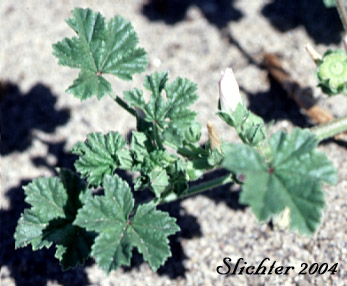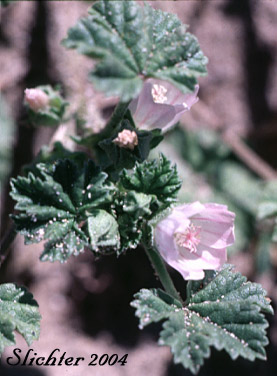

 The
photo at right shows the leaves and flower of dwarf mallow as seen on a sandy
beach above the high water mark at The Dalles Riverside Park...........August
26, 2001.
The
photo at right shows the leaves and flower of dwarf mallow as seen on a sandy
beach above the high water mark at The Dalles Riverside Park...........August
26, 2001.
Dwarf mallow is a spreading annual or biennial with several to many freely branched stems from 20-60 cm high. The stems and leaves are glabrous to sparsely haired. The leaf blades are kidney-shaped with heart-shaped bases. The blades average 1.5-4 cm long and are slightly 5-7 lobed. The margins are lined with rounded to acute teeth. The leaf petioles measure from 5-15 cm long.
1-3 flowers are found in each of the upper leaf axils. The flowers are pale bluish-lavender, pink or nearly white. The calyx measures 1/4- 1/2 the length of the corolla and is shallowly lobed. The corolla is broadly funnel-shaped and measures about 10-12 mm long. Each lobe of the corolla bears a shallow notch at the tip.
A weedy species, dwarf mallow may be found in disturbed, waste areas.
Introduced from Europe, dwarf mallow may now be found over much of the United States.
In the Columbia River Gorge, it may be found between the elevations of 100'-200' from near Rooster Rock east to Horsethief Butte.